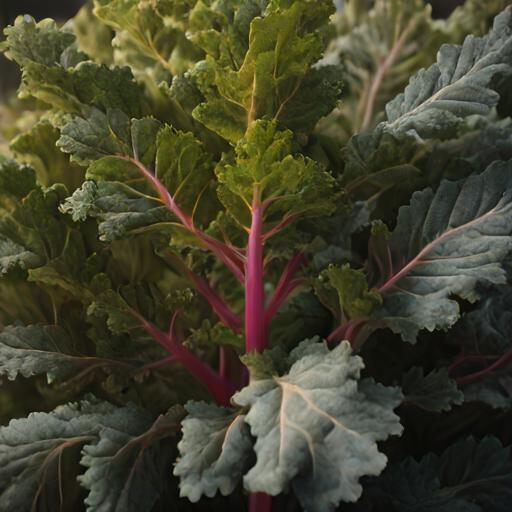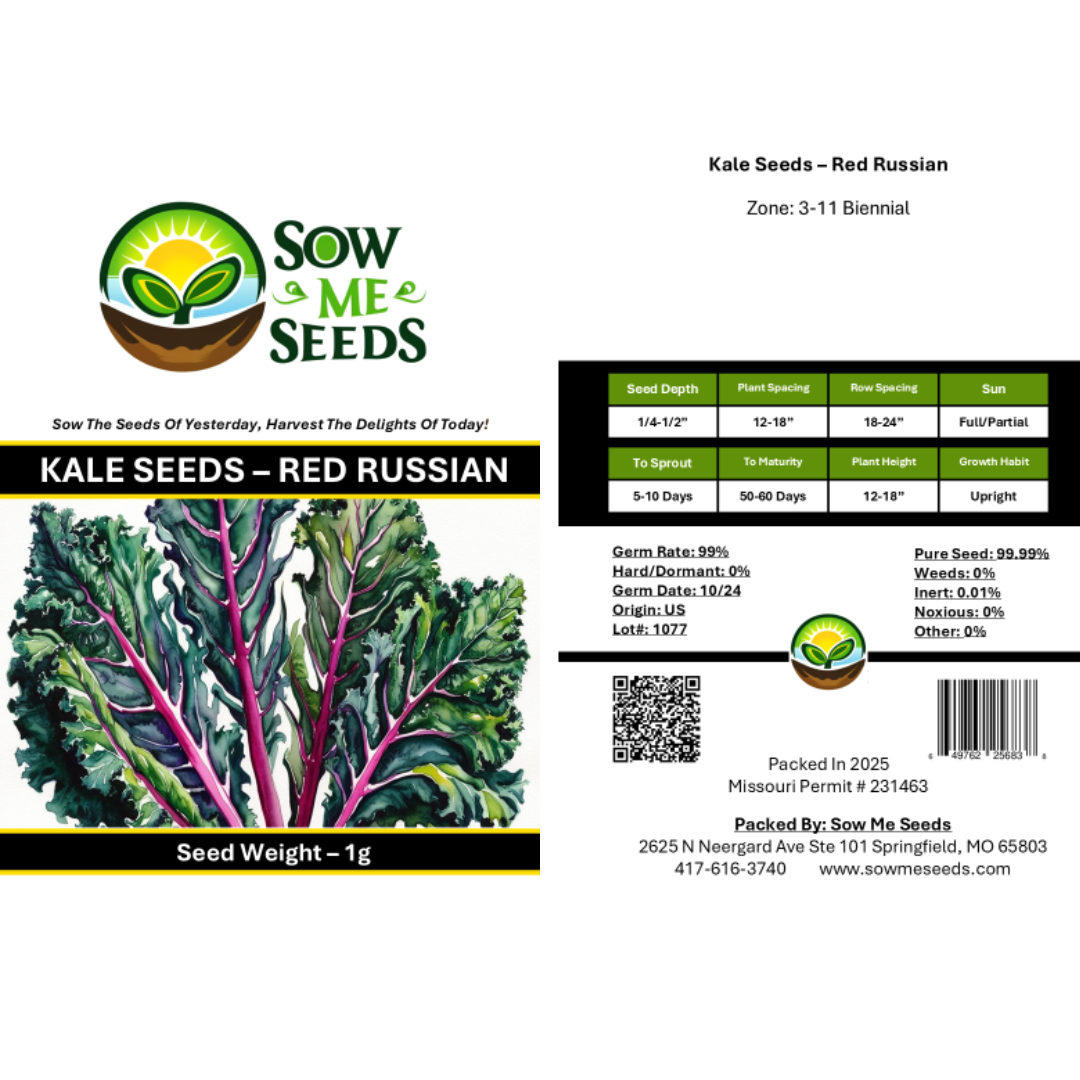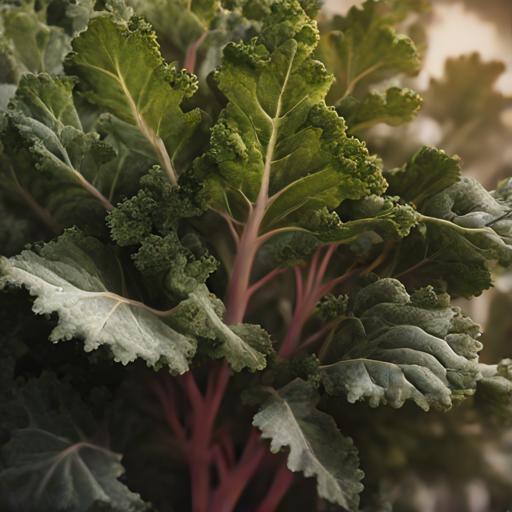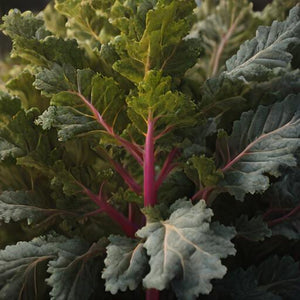- Hardiness Zone: 3-11 Biennial Often Grown As An Annual
Seed Depth: 1/4–1/2 inch
Seed Spacing: 12–18 inches
Row Spacing: 18–24 inches
Sunlight: Full sun to partial shade
Days to Sprout: 5–10 days
Days to Maturity: 50–60 days
Growth Habit: Upright, leafy biennial grown as an annual
Sunlight: Thrives in full sun but tolerates partial shade, especially in warmer climates.
Soil Type: Prefers rich, well-drained soil with a pH of 6.0–7.5. Adding compost improves soil fertility.
When to Plant: Sow seeds outdoors in early spring or late summer for a fall crop. For an earlier harvest, start seeds indoors 6–8 weeks before the last frost.
Direct Sowing: Plant seeds 1/4–1/2 inch deep, spacing them 12–18 inches apart. Thin seedlings to ensure proper spacing.
Indoor Sowing: Start seeds in trays and transplant when seedlings are 4–6 inches tall.
Succession Planting: Sow every 2–3 weeks for a continuous harvest during the growing season.
Watering: Keep the soil evenly moist, but not waterlogged, especially during dry periods. Mulch around plants to retain moisture and regulate temperature.
Fertilizing: Use a balanced fertilizer or compost at planting and mid-season to promote healthy leaf growth.
Pruning: Regularly harvest outer leaves to encourage new growth. Remove any yellowing leaves to maintain plant health.
Pest and Disease Control: Watch for cabbage worms, aphids, and flea beetles. Use row covers or organic pest control methods to protect plants.
When to Harvest: Harvest leaves when they are young and tender, typically 50–60 days after planting. Baby greens can be harvested earlier.
How to Harvest: Snip or gently pull outer leaves, leaving the central growing point intact for continuous harvests.
Seed Collection: Allow plants to bolt in their second year to produce seeds. Collect seeds from dry pods.
Storing Seeds: Store seeds in an airtight container in a cool, dry place.
Why You’ll Love It
Beautiful and Tasty: Flat, lobed leaves with purple veins add both visual appeal and delicious flavor to your garden.
Cold Hardy: Tolerates frost and gets even sweeter as temperatures drop — perfect for fall and winter growing.
Fast Growing: Quick to mature and great for multiple cuttings over a long season.
Tender Texture: Leaves are softer and more palatable than curly kales, making them perfect raw or cooked.
Plant Characteristics
Height: 18–24 inches
Growth Habit: Upright and leafy with deeply lobed, frilly leaves
Leaf Color: Blue-green with purple veins and reddish stems
Days to Maturity: 50–60 days
Hardiness: Biennial grown as an annual
Flavor and Culinary Uses
Flavor: Mild, slightly sweet, and nutty — especially after light frost
Culinary Uses: Great raw in salads, tossed in smoothies, sautéed, or added to soups and stews
Companion Planting Tips
Good Companions: Onions, beets, celery, and herbs like dill and chamomile
Avoid Planting Near: Pole beans and strawberries
Bonus Benefit: Attracts pollinators and beneficial insects while offering continuous harvests
Common Issues and Solutions
Cabbage Loopers and Aphids: Use neem oil or floating row covers early to prevent damage
Bitter Leaves: Harvest young and after frost for the sweetest flavor
Slow Growth: Enrich soil with compost and provide consistent moisture during dry spells
Seeds Per Packet
| 1g | Approximately 285 |
| 5g | Approximately 1,425 |
Why You’ll Love It
Beautiful and Tasty: Flat, lobed leaves with purple veins add both visual appeal and delicious flavor to your garden.
Cold Hardy: Tolerates frost and gets even sweeter as temperatures drop — perfect for fall and winter growing.
Fast Growing: Quick to mature and great for multiple cuttings over a long season.
Tender Texture: Leaves are softer and more palatable than curly kales, making them perfect raw or cooked.
Plant Characteristics
Height: 18–24 inches
Growth Habit: Upright and leafy with deeply lobed, frilly leaves
Leaf Color: Blue-green with purple veins and reddish stems
Days to Maturity: 50–60 days
Hardiness: Biennial grown as an annual
Flavor and Culinary Uses
Flavor: Mild, slightly sweet, and nutty — especially after light frost
Culinary Uses: Great raw in salads, tossed in smoothies, sautéed, or added to soups and stews
Companion Planting Tips
Good Companions: Onions, beets, celery, and herbs like dill and chamomile
Avoid Planting Near: Pole beans and strawberries
Bonus Benefit: Attracts pollinators and beneficial insects while offering continuous harvests
Common Issues and Solutions
Cabbage Loopers and Aphids: Use neem oil or floating row covers early to prevent damage
Bitter Leaves: Harvest young and after frost for the sweetest flavor
Slow Growth: Enrich soil with compost and provide consistent moisture during dry spells
Seeds Per Packet
| 1g | Approximately 285 |
| 5g | Approximately 1,425 |





Share and get 15% off!
Simply share this product on one of the following social networks and you will unlock 15% off!